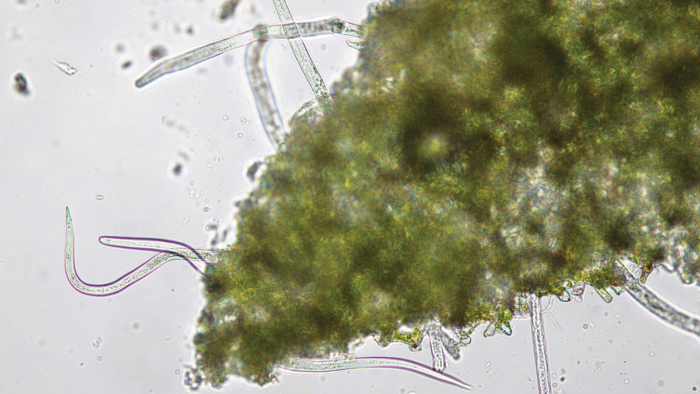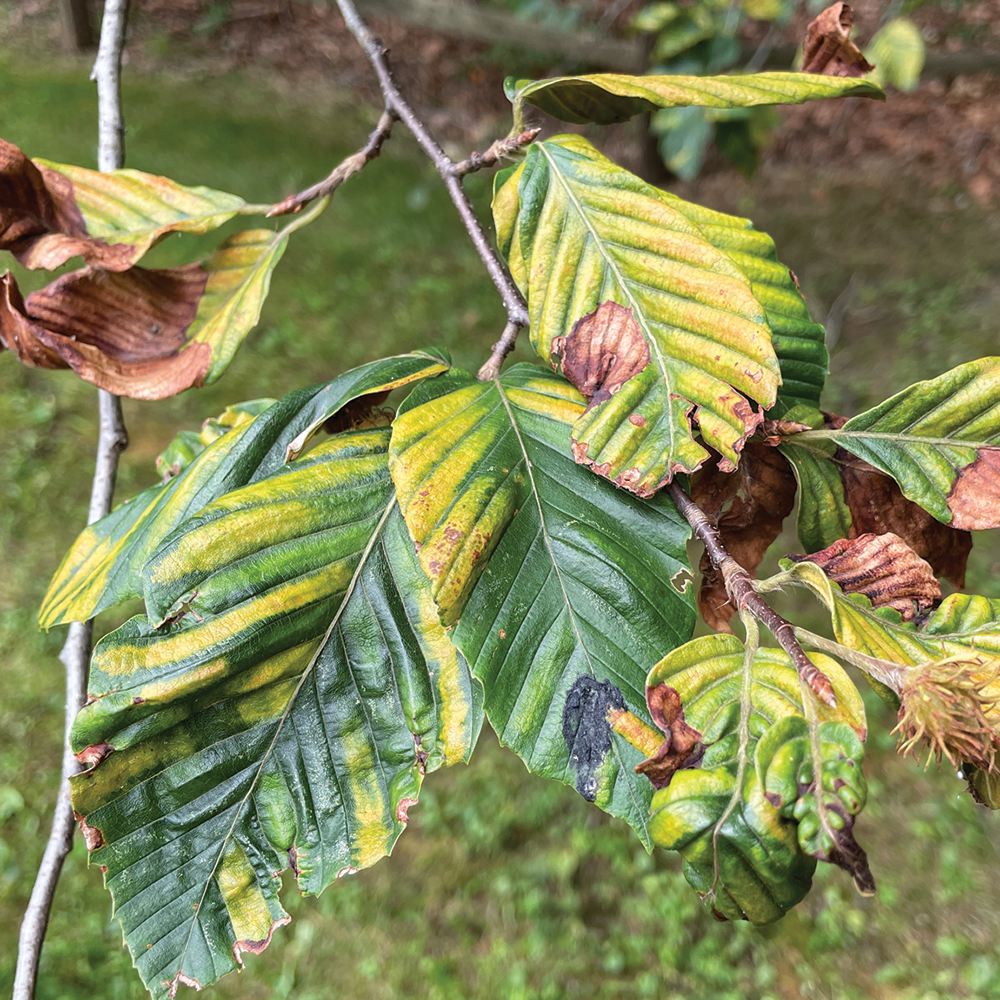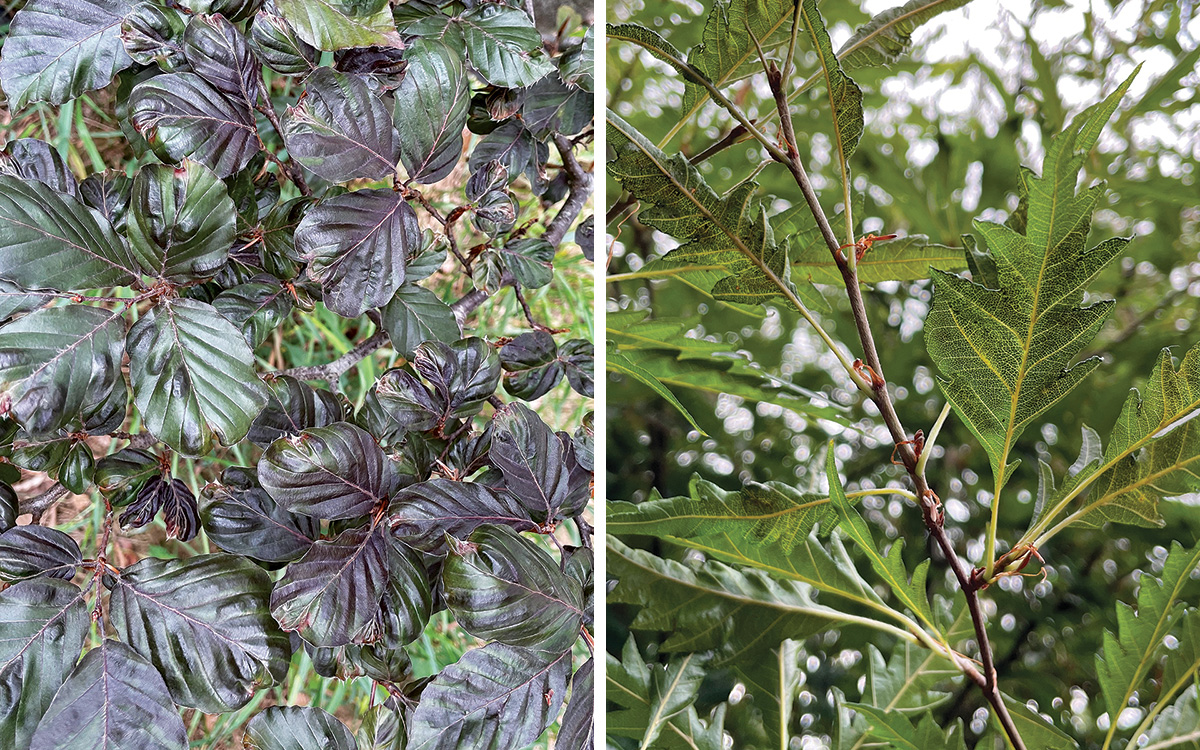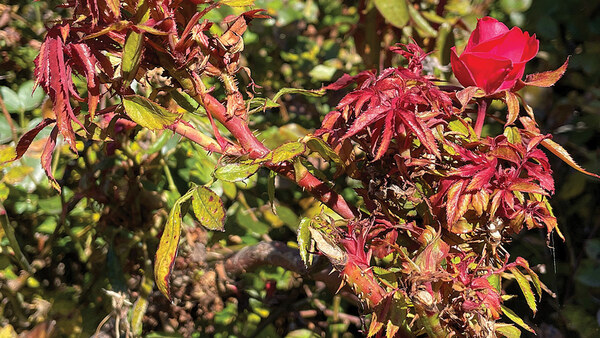
Gardeners best know two kinds of nematodes: those that are destructive root pests, and those that are beneficial and may be purchased to help control soil grubs, fungus gnats, thrips, and some other pests. However, there are many other lesser-known groups of these tiny roundworms that are no less important. The pine wilt nematode causes rapid death of many nonnative pine species (Pinus spp. and cvs.) that are important in our landscapes, such as Scots, mugo, and Austrian pines. And foliar nematodes are common pests of many perennial plants, such as hosta (Hosta spp. and cvs.) and peony (Paeonia spp. and cvs.).
Of course, most nematodes are not pests, as there are countless species of soil nematodes that feed on fungi and bacteria, thereby assisting with a healthy soil food web. But there is a new and particularly troubling nematode that gardeners must be aware of, because it is rapidly gaining notoriety as beech leaf disease gains ground.
Where did it come from?
Beech leaf disease (or BLD, as many call it) was first noticed on beech trees (Fagus spp. and cvs.) in 2012 by a forest biologist in Lake County, Ohio. Trees had strange symptoms of shriveled leaves and dark green leaf banding. Soon they began to die. Over the next few years, observations rolled in at an alarming rate from eastern Ohio, western Pennsylvania, New York, and Ontario. In 2019, reports were published from Connecticut, with other parts of New England soon following. Such rapid spread is shocking, but it may be that the disease has existed in some of these areas for several years and simply went unnoticed until attention was drawn to it and people began looking for it.
Scientists worked hard to understand the disease, which seemed unlike anything encountered previously. Fungi, viruses, bacteria, phytoplasmas, and more were considered as the cause. However, a strange nematode was always found on infected trees and proved the most likely culprit causing the damage. Dubbed the beech leaf nematode, it was determined to be a new subspecies of Litylenchus crenatae, a species only recently discovered in Asia.
What does this disease look like?
In early stages, affected beech leaves show a dark green, irregular banding—a tell-tale symptom best seen from below. Aphids can cause similar chlorotic banding, and eriophyid mites can cause similar patches of white to yellow velvety bands on beech leaves. However, the symptoms of this beech affliction become more distinct with time. Research shows that the nematodes travel to buds in the late summer and cause damage within the bud tissue itself, which seems to get progressively worse each year.
 |
 |
Unfurling spring leaves may show more serious symptoms of damage: crinkling, hardened, thick tissue, yellowing, and distortion. Leaves are the power plants of a tree, producing energy and food as carbohydrates. If the leaves are not functional, resources are gradually depleted and the trees decline. It appears that beech trees infected for multiple seasons literally starve to death over the course of five to seven years, although in some areas of New England, young trees seem to be dying even more rapidly.
How big is this problem?
It will be some time before we know for sure, but right now the situation is increasingly troubling to many foresters, ecologists, and gardeners. Beech is a critical species for native wildlife. The loss of beech would be especially serious in the wake of previous ecological upheaval. Widespread damage or complete loss of American chestnut (Castanea dentata), ash trees (Fraxinus spp. and cvs.), eastern hemlock (Tsuga canadensis), and some oaks (Quercus spp. and cvs.) has altered and realtered Northeastern forests dramatically this century.
To make a bad situation worse, this is not the only notable problem for beech trees in the region. Beech scale, an invasive insect that appears as small, cottony spots or patches on beech trunks and branches, was accidentally brought from Europe to Nova Scotia in 1890 and spread slowly southward over the next century. It presently occupies much of the beech forests in New England and parts of the Mid-Atlantic and Midwestern regions. The insect feeding alone causes little harm, but it is closely associated with two fungal pathogens that soon follow infection. These pathogens cause the bulk of the damage and eventual tree death as beech bark disease cankers develop.

What can we do about it?
Right now, the best thing to do is go out and scout your beech trees. Report the disease to your county and state authorities if you find it in a new area. Second, avoid buying and moving beech trees. While some tree nurseries from affected regions are voluntarily halting sales, early disease symptoms can be difficult to spot, and there is currently no official quarantine on the disease to reduce the spread of infected trees. How exactly the beech leaf nematode is spreading at such a rapid pace through forested natural areas is currently unknown and an important future research topic.
Several research groups are conducting trials to attempt control of the nematode. There are some promising options, including enhancing plant defenses, but there are no quick fixes or guaranteed cures. Also, several aspects of the beech leaf nematode life cycle and feeding habit within the dormant buds make it unique and particularly difficult to target with known methods. Research will take time.
Unfortunately, American beech (Fagus grandifolia) is not the only species affected by BLD. European beech (F. sylvatica) and Oriental beech (F. orientalis) also appear to be susceptible, although tolerance levels have not yet been carefully studied. This means that many of the beech cultivars and selections popular in landscapes are also at risk, such as copper beech (F. sylvatica f. purpurea) and fern-leaved beech (F. sylvatica var. heterophylla ‘Aspleniifolia’).
For now, try to keep your beech trees otherwise healthy by minimizing stress factors and by providing them with everything they need to keep up their natural defenses. Proper irrigation, fertilizing based on soil tests, and mulching to enhance soil and root function are all important for tree resilience.
Matthew Borden, DPM, is a plant health consultant specializing in diagnostics and integrated management of landscape plant pests and diseases.
Photos, except where noted: Matthew Borden
Fine Gardening Recommended Products

Pruning Simplified: A Step-by-Step Guide to 50 Popular Trees and Shrubs
Fine Gardening receives a commission for items purchased through links on this site, including Amazon Associates and other affiliate advertising programs.

ARS Telescoping Long Reach Pruner
Fine Gardening receives a commission for items purchased through links on this site, including Amazon Associates and other affiliate advertising programs.

isYoung Birdlook® Smart Bird Feeder with Camera
Fine Gardening receives a commission for items purchased through links on this site, including Amazon Associates and other affiliate advertising programs.



















Comments
Log in or create an account to post a comment.
Sign up Log in